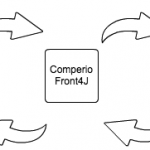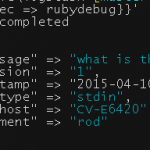Elastic{ON}15: Day two
March 11, 2015
Keynote
 Fighting the crowds to find a seat for the keynote at Day 2 at elastic{ON}15 we were blocked by a USB stick with the curious caption Microsoft (heart) Linux. Things have certainly changed.
Fighting the crowds to find a seat for the keynote at Day 2 at elastic{ON}15 we were blocked by a USB stick with the curious caption Microsoft (heart) Linux. Things have certainly changed.
Microsoft
The keynote, led by Elastic SVP of sales Aaron Katz, included Pablo Castro of Microsoft who was keen to explain how this probably isn’t so far from the truth. Elasticsearch is used internally in several Microsoft products among Linux and other open source software and this is a huge change from the Microsoft we know from around five years ago. Pablo revealed some details towards how elasticsearch is used as data storage and search platform in MSN, Microsoft Dynamics and Azure Search. Microsoft truly has gone through some fundamental changes lately embracing open source both internally and externally. We see this as a demonstration of the power of open source and the huge value of Elastic(search) brings to many organizations. As Jordan Sissel said in the keynote yesterday “If a user has a problem, it is a bug”. This is a philosophical stance towards a conception of software as an enabler of creativity and growth, in contrast to viewing software as a fixed product packaged for sale.
Goldman Sachs
Microsofts contribution was in the middle part of the keynote. The first part was a discussion with Don Duet, managing director of Goldman Sachs. Goldman Sachs provides financial services on a global scale, and has been on the forefront of technology since its inception in 1869. They were an early adopter of Elasticsearch since it was as an easy to use search and analytics tool for big data. Goldman Sachs is now using elasticsearch extensively as a key part of their technological stack.
NASA
The most mind blowing part of the keynote was the last one held by two chaps from the Jet Propulsion Labs team at NASA, Ricky Ma and Don Isla. They first showed their awesome internal search with previews, and built in rank tuning. Then they talked about the Mars Curiosity rover, a robot planted on Mars which runs around taking samples and selfies. It constantly sends data back to earth where the JPL team analyzes the operations of the rover. Elasticsearch is naturally at the center of this interplanetary operation, nothing less.

Mars Curiosity Rover Selfie
The remainder of the day contained sessions across the same three tracks as the first day. In addition five tracks of birds of a feather or “lounge” sessions were held where people gathered in smaller groups to discuss various topics. Needless to say the breadth of the program meant we were stretched thin. We chose to focus on three topics that are of particular importance to our customers: aggregations, security & Shield, and resiliency
More aggregations
Adrien Grand & Colin Goodheart-Smithe did a deep dive into the details of aggregations and how they are computed. In particular how to tune them and the results in terms of execution complexity. A key point is the approximations that are employed to compute some of the aggregations which involve certain trade offs in speed over accuracy. Aggregations are a very powerful feature requiring some some planning to be feasible and efficient.
Security/Shield
Uri Boness talked about Shield and the current state of authentication & authorization, He provided some pointers to what is on the roadmap for the coming releases. Unfortunately, there does not appear to be any concrete plans for providing built in document level security. This is a sought after feature that would certainly make the product more interesting in many enterprise settings. Then again, there are companies who provide connector frameworks that include security solutions for elasticsearch. We had a chat with some of them at the conference, including Enonic, SearchBlox and Search Technologies.
Peter Vulgaris from Facebook explained how they are using elasticsearch. To me, the story resembled Microsoft’s. Facebook has heaps of data, and lots of use cases for it. Once they started to use elasticsearch it was widely adopted in the company and the amount of data indexed grew ever larger which forced them to think more closely about how they manage their clusters.
Resiliency
Elasticsearch is a distributed system, and as such shares the same potential issues as other distributed systems. Boaz Leskes & Igor Motov explained the measures that have been undertaken in order to avoid problems such as “split-brain” syndrome. This is when a cluster is confused about what node should be considered the master. Data safety and security are important features of Elasticsearch and there is a continuous effort in place in these areas.
Lucene
Stepping back to day 1 and the Lucene session featuring the mighty Robert Muir, we learned that Lucene version 5 includes a lot of improvements. Especially performance wise regarding compression both on indexing and query times which enables faster execution times and reduces resource consumption. There has also been made efforts to the Lucene core enabling a merging of query and filter as two sides of the same coin. After all a query is just a filter with a relevance score. On another note Lucene will now handle caching of queries by itself.
Wrapping it up
Elastic{ON}15 stands as a confirmation of the attitude that were essential in the creation of the elasticsearch project. The visions that guided the early development are still valid today, except the scale is larger. The recent emphasis on stability, security and resiliency will welcome a new wave of users and developers.
At the same time there is a continuous exploration and development into big data related analytics but with the speed and agility we have come to expect from Elasticsearch.
Thanks for this year, looking forwards to next!








[…] http://blog.comperiosearch.com/blog/2015/03/19/elasticon15-day-two/ […]
Nice write up! I didn’t realise Microsoft used Elasticsearch. Good to know.